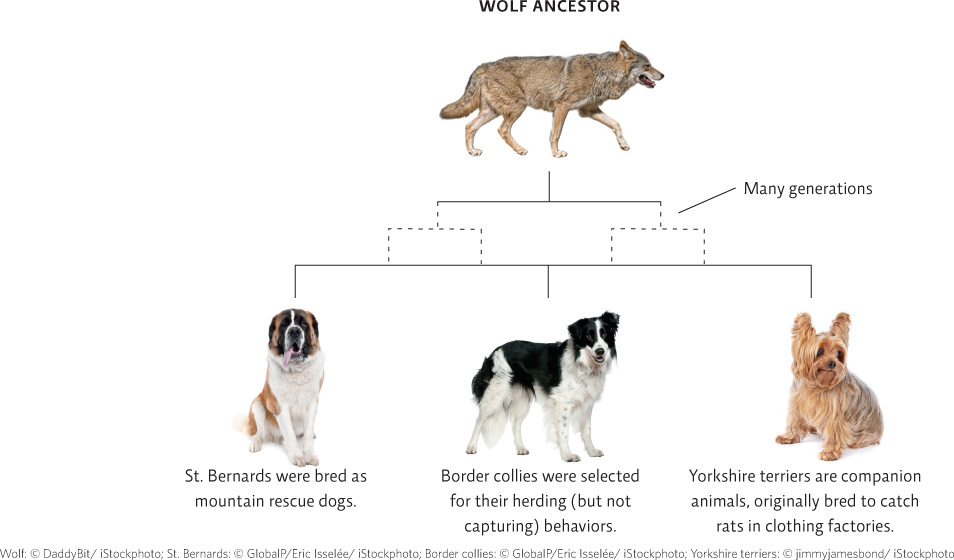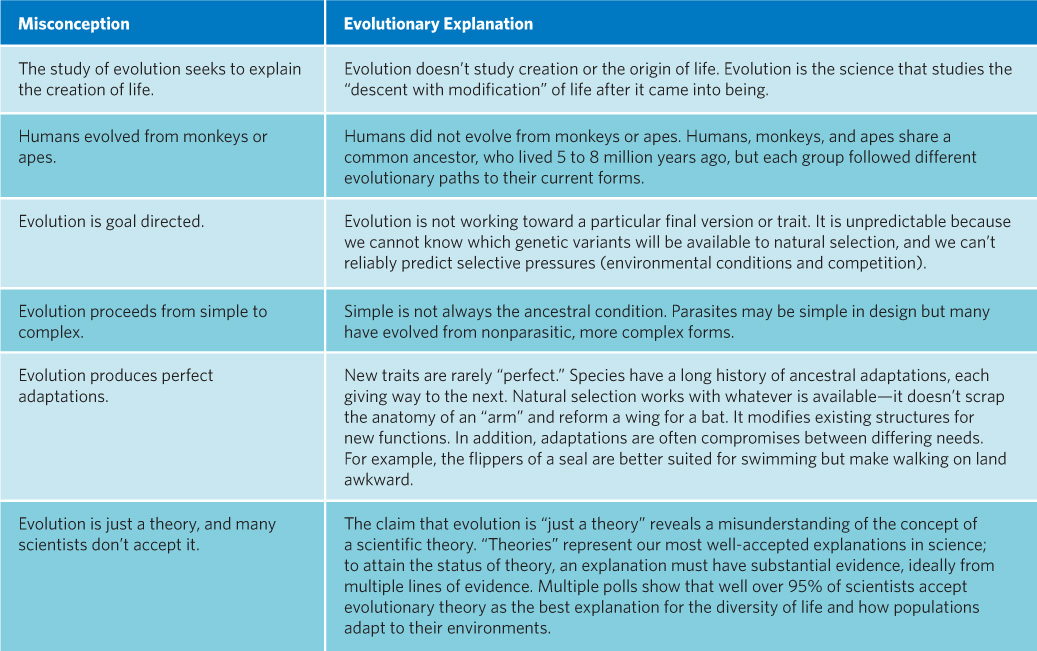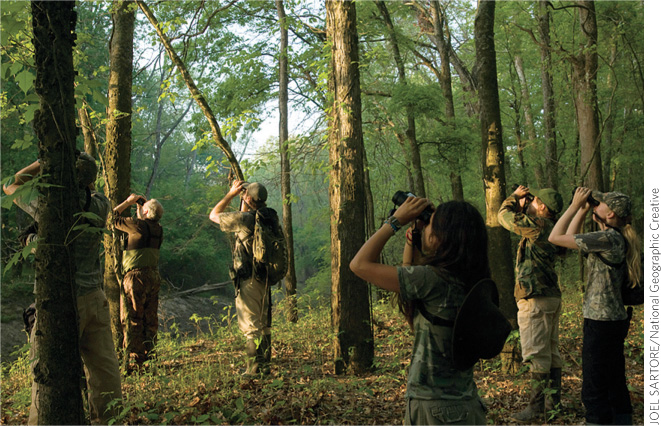Humans affect evolution in a number of ways.
The introduction of the brown tree snake to Guam was an accident: A snake hitchhiker crossed the ocean on a human tanker—unbeknownst to the crew—and landed in a veritable bird buffet. But humans also directly affect the evolution of a population through artificial selection. Artificial selection works the same way as natural selection but the difference is that the selective pressure is us. For many animal species, from pets to farm animals and plant species, humans choose who breeds with whom in an attempt to produce new individuals with the traits they desire. By doing this over many generations, people have accentuated certain plant and animal traits, sometimes to extremes. For instance, artificial selection created domestic dogs from their wolf ancestors. INFOGRAPHIC 11.7
artificial selection
A process in which humans decide which individuals breed and which do not in an attempt to produce a population with desired traits.
All dogs (Canis lupus familiaris) are descendants of the wolf (Canis lupus). By only breeding those males and females with the traits desired (size, herding ability, protective instinct, etc.), humans have created more than 170 dog breeds.

Wolf: © DaddyBit/iStockphoto; St. Bernards: © GlobalP/Eric Isselée/iStockphoto; Border collies: © GlobalP/Eric Isselée/iStockphoto; Yorkshire terriers: © jimmyjamesbond/iStockphoto

Why can we say that artificial selection is goal directed but natural selection is not?
In artificial selection, humans do have a goal in mind and select breeding individuals based on the traits that the breeder wants to perpetuate and enhance (i.e. herding behavior in dogs or seed production in wheat). It takes many, many generations to achieve the desired goal. In natural selection, however, selection is based on what is best suited at that particular time, not what might be useful in the future. It is more appropriate to say natural selection is responsive to environmental changes but it cannot anticipate future needs and does not select a trait with a future goal in mind.

KEY CONCEPT 11.8
Artificial selection works by the same mechanisms as natural selection except that humans choose which traits to keep and which to eliminate from a population through selective breeding. We can also inadvertently act as a selective pressure with any action that favors some traits over others, such as our use of pesticides or antibiotics that lead to resistant populations.
But evolution is ever at work. Pesticide-and antibiotic-resistant populations can emerge as an inadvertent human-influenced selection. When we apply a chemical that kills a pest or pathogen, some individuals survive because of their natural genetic resistance; that is, the individuals were already resistant even though they had never encountered the chemical. These survivors are then the only individuals who reproduce, producing the next generation that is also pesticide resistant, ultimately changing the frequency of resistant genes in the population (see Chapter 17).
Evolution can be a contentious subject for some people who feel it conflicts with other views they hold. Whether you are convinced by the physical, scientific evidence that evolution has occurred or that natural selection is a mechanism by which it occurs, it is important that you base your criticisms of the theory on sound science and not on misconceptions of evolutionary theory. TABLE 11.1
The theory of evolution as a reasonable explanation for the diversity of life is contested by some people, but many of their arguments are based on misconceptions. Understanding the basic tenets of evolutionary theory is the first step in critically evaluating its validity.


Some people reject evolution as a reasonable explanation for the diversity and ancestry of life on Earth, especially regarding humans. What reasons are most often offered for this rejection? Are these reasons scientific? Do they have to be?
Answers will vary but may include reference to religious beliefs. It is important to not criticize or ridicule personal beliefs. An individual may bring things other than empirical evidence to the table when answering this question and that is their prerogative. Rejecting evolution on the basis of the scientific evidence is hard to do but rejecting it because it conflicts with personal beliefs or underlying assumptions (i.e. the Earth is only 10,000 years old) that come from other sources of information may be reasonable for a given individual who is unwilling to alter those beliefs or assumptions.
This is a good discussion question in class or small groups or offered as an anonymous question that students can address and turn in so that they can share their thoughts without fear of being ridiculed or criticized.
Ultimately, by changing the environment rapidly, humans apply a number of new selective pressures on populations. Our changes have the capacity to be so great that natural selection simply cannot keep up: A new needed trait is not present in the population, or it cannot spread quickly enough to prevent a population collapse. The accidental introduction of the predatory brown tree snake is one such example; it introduced a major change, basically overnight, that was able to eat its way through the vertebrate populations before those populations could adapt.
Now, however, things are looking up for the birds of Guam. Thanks to efforts by the Guam Department of Agriculture and the USDA Wildlife Services, brown tree snakes are being controlled to allow the remaining bird populations to recover.
KEY CONCEPT 11.9
There are many misconceptions about evolution among the general public, especially for those who feel it conflicts with personal beliefs. Understanding what science actually says evolution is (and is not) is an important first step to critically evaluate the soundness of evolutionary theory.
“We are using traps in northern Guam to control snakes in areas where we would like to reintroduce native species,” explains Diane Vice, a wildlife biologist with the Guam Department of Agriculture. Her organization is also working to prevent the snakes from infiltrating Cocos Island, the atoll off of southern Guam, and an important haven for nesting sea birds, Micronesian starlings, and sea turtles. Scientists are also close to perfecting the mouse-drop strategy.
A follow-up study done by the Agriculture Department indicates that in earlier tests, the snakes did devour “dead neonatal mice adulterated with 80 mg acetaminophen” and that “baiting” with laced mice was effective in killing the snakes. The study also suggests that the impact on other species will be minimal; for one thing, the snakes have already wiped out the birds that might have also fallen prey to the dead mice. “One concern was that crows may eat mice with the toxicant,” says William Pitt, of the U.S. Wildlife Research Center’s Hawaii Field Station. “However there are no longer wild crows on Guam.”
Vice says the goal is not to eradicate the snakes (which probably isn’t possible) but to control and contain them so that they don’t find their way to other islands, as they found their way to Guam. “The hope is to create safe habitat,” Vice says, so that these beautiful native species can once again thrive.
Select References:
Clark, L., et al. (2012). Efficacy, effort, and cost comparisons of trapping and acetaminophen-baiting for control of brown treesnakes on Guam. Human–Wildlife Interactions, 6(2): 222–236. http://www.aphis.usda.gov/wildlife_damage/nwrc/publications/12pubs/clark122.pdf.
He, F., & S. P. Hubbell. (2011). Species-area relationships always overestimate extinction rates from habitat loss. Nature, 473(1747): 368–371.
Hoekstra, H. E., J. G. Krenz, & M. W. Nachman. (2005). Local adaptation in the rock pocket mouse (Chaetopidus intermedius): Natural selection and phylogenetic history of populations. Heredity, 94(2): 217–228.
Owens, I. P. F, & P. Bennett. (2000). Ecological basis of extinction risk in birds: Habitat loss versus human persecution and introduced predators. Proceedings of the National Academy of Sciences, 97(22): 12144–12148.
Pimm, S., et al. (1995). The future of biodiversity. Science, 269(5222): 347–350.
Pimm, S., et al. (2014). The biodiversity of species and their rates of extinction, distribution, and protection. Science, 344(6187):1246752.
Savidge, J. A. (1987). Extinction of an island forest avifauna by an introduced snake. Ecology, 68(3): 660–668.
Vice, D. S., et al. (2005). A comparison of three trap designs for capturing brown treesnakes on Guam. USDA National Wildlife Research Center, Staff Publications, Paper 43, http://digitalcommons.unl.edu/cgi/viewcontent.cgi?article=1041&context=icwdm_usdanwrc.
PERSONAL CHOICES THAT HELP
The astonishing variety of life found on Earth is a result of natural selection favoring those individuals within populations that are best able to survive in their particular environment. Given enough time, some populations may be able to adapt to environmental changes. However, human activities may disrupt natural ecosystems so that organisms cannot adapt fast enough to survive, and those organisms may go extinct. Conservation activities can help protect vulnerable organisms and ecosystems.
Individual Steps
•Live in an older, established area of your community. Suburban sprawl reduces habitat for wildlife, and reliance on cars causes greenhouse gas emissions that could result in species-threatening climate change.
•Save your pocket change and at the end of every year donate the money to a land, marine, or wildlife protection agency.
•Create a personal blog that includes photographs of wildlife, facts about current threats to plants and animals, and articles about conservation.
Group Action
•Throw a party in support of wildlife conservation. Take a collection at the door and donate the money to an organization that supports conservation.
Policy Change
•“Adopt an Organism.” The U.S. Fish and Wildlife Service maintains a database of endangered plants and animals in every state. Research this database to find wildlife that interests you. Determine what agency, conservation group, or legislator you could contact and then start your own protection campaign. See what meetings, petitions, and legislation could impact your organism and get involved.
